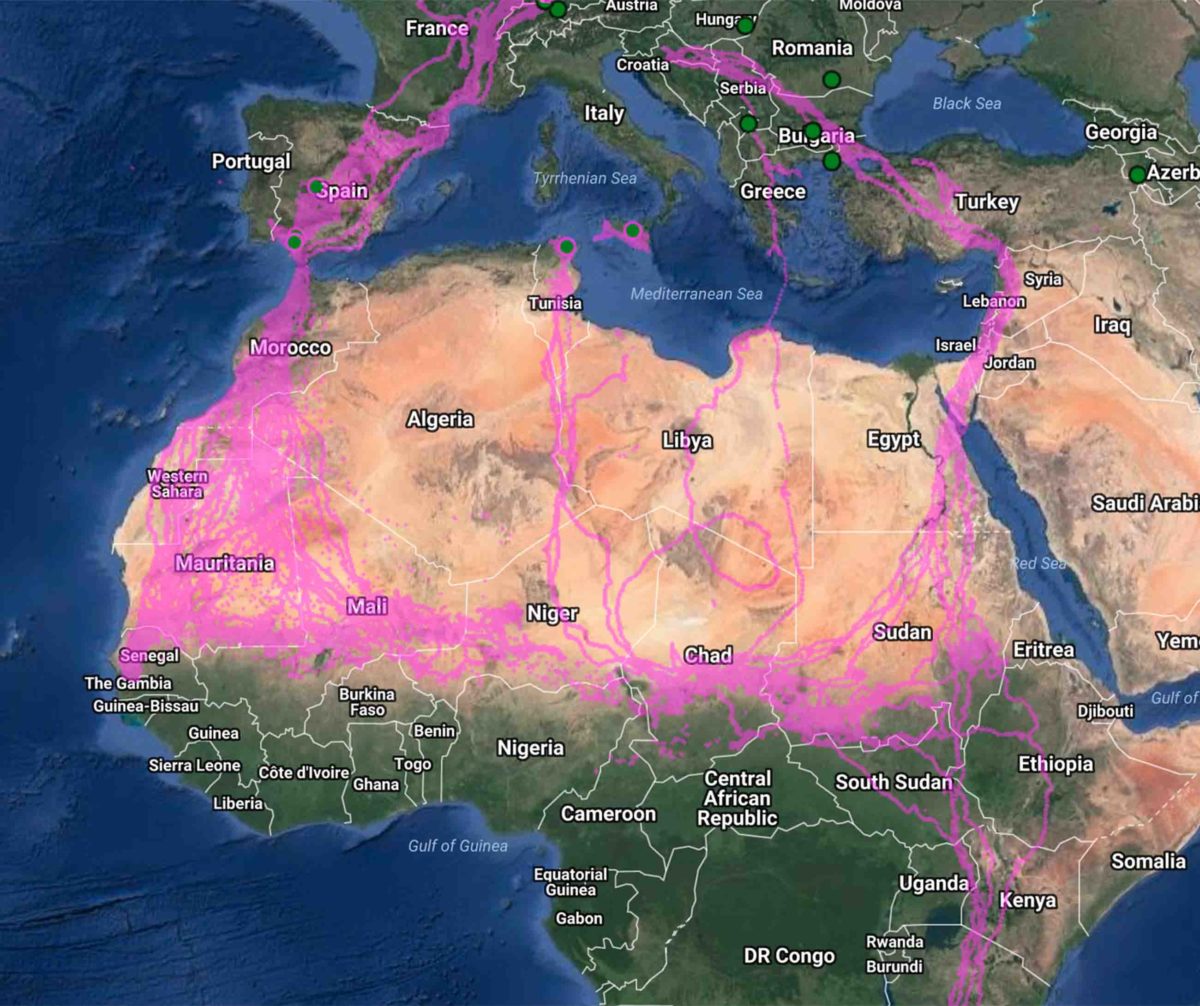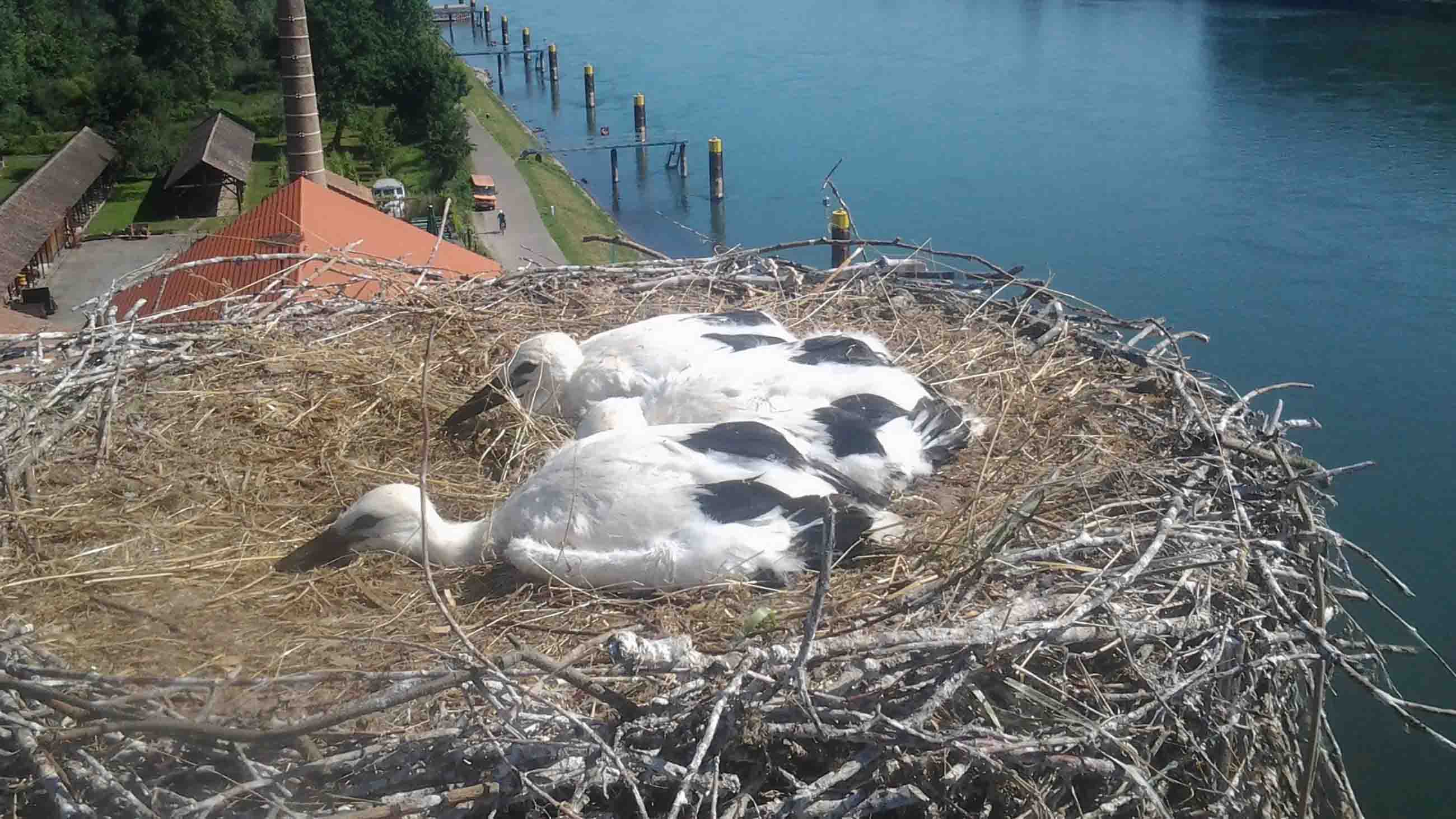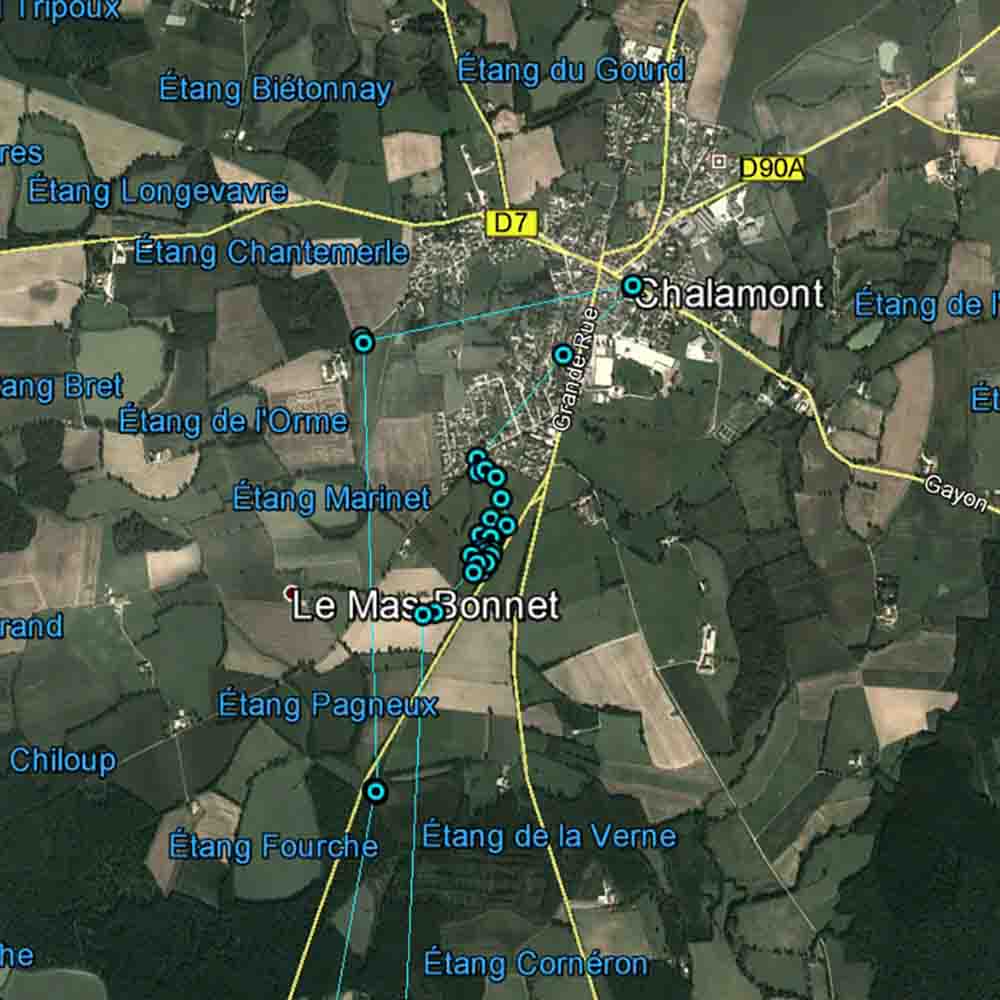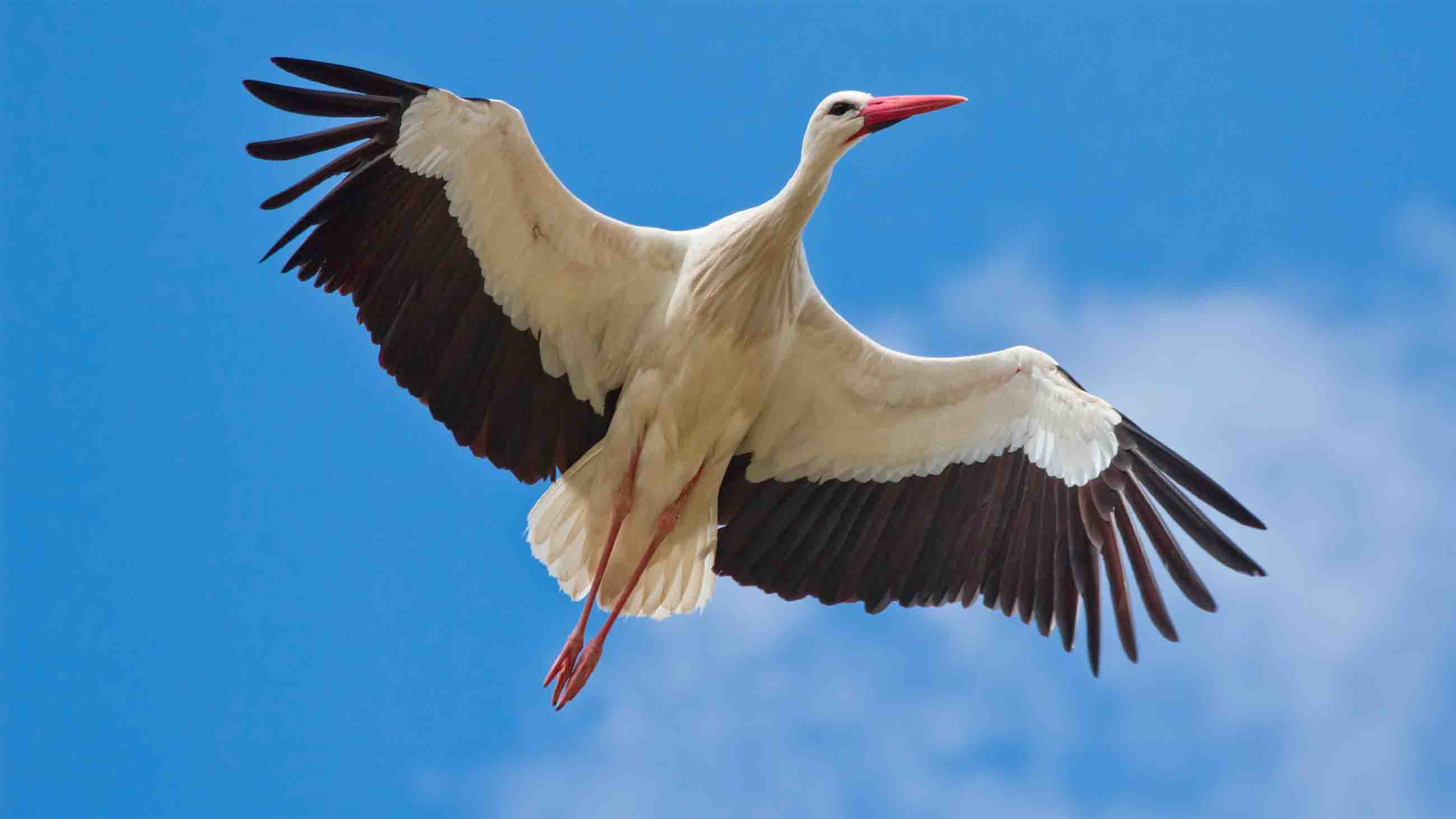Across the Web, and the World, Citizen Scientists Help Track Animal Migrations
Every morning, retired biology teacher Ingrid Dorner opens her laptop to check in on 14 white storks who roam the villages, fields, and forests near her home in western Germany. Two years ago, the birds were outfitted with satellite transmitters, part of a research study at the Max Planck Institute for Ornithology. “When one doesn’t send a proper signal, or transmits from the same place, then I do get nervous,” says Dorner, through a translator. Along the migration, white storks may be preyed on, shot, or — most commonly — electrocuted. “They hang from the power lines,” she says.

Pink lines in the Movebank database trace the movement of various storks from Europe to northern Africa and back.
Visual: Movebank via Google Imagery/NASA
She zooms in on the dot on the map that represents Marieta, a female stork that took her first, clumsy test flights in 2016, at an abandoned brick factory along the Rhine. Dorner collects Google Earth screenshots from places Marieta has visited: the lush, rolling fields outside of Lyon, France, for example, or a landfill outside of a Moroccan city. In Spain, dots along the concrete wall of a maximum-security prison suggest that Marieta had found an ideal hunting perch.
“A curious picnic area,” Dorner says.
Dorner is a citizen scientist animal tracker, and there are tens of thousands like her worldwide. Their numbers are growing in tandem with the ambitions of migration scientists, who are finding novel uses for ever-smaller GPS satellite transmitters, which they are able to place on new species every year. With the aim of engaging the public and enhancing research, scientists are eagerly sharing animal movement data through websites like the Movebank database or apps like the Animal Tracker. And while some critics worry about the unintended consequences of arming thousands of laypeople with the ability to track wildlife movement in real time, advocates argue that the data is providing scientists with valuable information — and also creating the kind of community that some experts believe is needed to augment conservation efforts.
Take the reintroduction in Europe of the northern bald ibis, or waldrapp, led by Austrian biologist Johannes Fritz. In the spring of 2004, Fritz adopted seven waldrapp chicks from the Vienna Zoo and the Zurich Zoo. That fall, after they had imprinted on him as a parent of sorts, he taught them how to migrate, guiding them with an ultralight aircraft.
Today, there are around 90 birds. About one-third were born in the wild, and they learned migration routes from their parents or other older waldrapps. With their glossy black feathers, shocking pink, bald faces, and narrow feathers spiked atop their heads — punk-rock style — the birds have garnered many fans. “When you see the bird for the first time, you feel it’s ugly, but the more you see it, the more it’s fascinating,” says Fritz. The ugly-beautiful waldrapps are all carrying transmitters and they’re cheered along their migration route — virtually and, sometimes, in person.
During last fall’s migration over the Alps, a juvenile bald ibis named Waldemar got left behind during a snowfall. It was Waldemar’s first flight, so he didn’t know the way. Fritz knew the bird was lost, but he didn’t know where: The transmitter’s solar-powered battery had conked out.
Fortunately, a woman in Austria had been following the migration on Animal Tracker. When the birds’ signals neared her village, she ventured out to find them. But instead of finding the flock, she spotted Waldemar, by himself, in a snow-covered field. The woman contacted the waldrapp project. Soon, the bird was collected by a team member, housed overnight, and transported further south to an older waldrapp, about 40 miles away.
In addition to contending with the weather, waldrapps must also survive migration along a heavily hunted corridor from northern to central Italy. Fritz has set up a volunteer task force of around 700 people who live along the route, including bird watchers, citizen scientists, and hunters. Communicating through WhatsApp, the volunteers alert hunters to be careful when the birds are nearby. Waldrapps are still shot, at least one every year, but Fritz says the number of downed waldrapps is decreasing in proportion to their growing numbers. With so many watching out for the bald ibises, would-be poachers know their chances of being caught, and prosecuted, are high.



Citizens are also playing a key role in academic research. Wolfgang Fiedler, the lead researcher for the white stork study, says citizens are the scientists’ eyes on the ground. “They can give us all kinds of information that the trackers do not,” says Fiedler.
In the winter of 2014, for example, a French bird watcher emailed Fiedler to let him know he’d be travelling to Senegal. “Is there something I can observe for you?” he asked. Fiedler wanted to know what one of the tracked storks was doing along a river there. The volunteer altered his itinerary, and sent back pictures of roughly a thousand storks, who were hunting in the farmlands along the river. Research has shown that, increasingly, stork populations are making very different decisions about how far to migrate and what to eat, due to climate change, new landfill sites, and habitat loss. The details about the bird’s diet, along with the news of additional storks, provided “very valuable information,” says Fiedler.
In other cases, users simply upload photos or observations to the Animal Tracker app. Download it to your phone and you can see movement data for 17 species, including 75 white storks, nine turkey vultures, and 14 rough-legged buzzards. Click on Zozu, a white stork, and you’ll read that she was born in 2013 in south Germany and has two living siblings. Click “add observation” and instructions pop up: “Is it alone, together with conspecifics, or with individuals of other species? Is it feeding? Can you identify its food?” Fiedler says Animal Tracker users tend to choose favorite birds to follow closely. “It could be one from their village but often it’s chosen randomly and they look every day at what this bird is doing.”
In March, the app will be updated to include movement data for more species including whales, baboons, and bears. Users will be able to define a radius, say 12 miles, and get notifications when a tracked animal is in their vicinity. And users will be able to communicate with each other. This is key for strength-in-numbers conservation advocacy, says Michael Quetting, who is leading the redesign at the Max Planck Institute.
For all the excitement over such public involvement in migration research, some scientists have voiced concerns over the potential downsides of making this sort of movement data public. “Should animals have privacy?” said Steven Cooke, a Canadian biologist who has put trackers on fish. “Every time a bloody stork lands, does it need to have binoculars on it?”
In the October issue of the journal Conservation Biology, Cooke and his co-authors explained their concerns about the public sharing of animal GPS data. For one, the data can be used for non-conservation purposes: wildlife photography, for example, or even poaching. Some degree of human observation may be benign, but a well-known study published in 2004 showed that juvenile hoatzins from nests visited by eco-tourists had higher death rates, possibly because of their more frequent stress hormone surges.
Cooke isn’t saying migration data should never be shared, but he thinks the citizen science tracking projects should be rolled out more slowly and on a smaller scale, with carefully controlled studies to monitor any deleterious effects. And Fiedler, the stork researcher, agrees that caution is necessary, “especially with some species and the time of year.” The community of Movebank users, meanwhile, is in the early stages of developing guidelines to monitor and mitigate harms.
But when it comes to their research projects, both Fiedler and Fritz think citizen trackers yield far more benefit than harm.
Like it or not, they say, humans are affecting animal migrations, with powerlines, lit windows, pollution, and bullets. As Fritz sees it, citizen trackers can make their communities care more about the struggles of migrating animals by sharing their names, stories, and even memories.
“It’s not just rational for people but emotional,” he says. “You protect what you know.”
Wendy Glauser is a Toronto-based journalist whose work has appeared in numerous magazines and newspapers, including the The Globe and Mail, The Medical Post, The Walrus, The Toronto Star, the Canadian Medical Association Journal, Chatelaine, and Healthy Debate.










